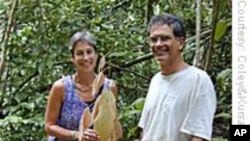<!-- IMAGE -->
Biologists Phyllis Coley and her husband Tom Kursar are experts on plant toxins. Although they teach at the University of Utah, they spend much of their time working in forests around the world. Coley says they witnessed alarming rates of deforestation and, "had this midlife crisis where we thought that we wanted to try to save the rainforest."
Pharmacological drugs are sourced from the rainforest
Twenty-five percent of all drugs we use today were derived from rainforest organisms. Seventy percent of plants with known anti-cancer properties are from rainforests. For example, quinine, from the South American cinchona tree, was once the only treatment for malaria; the anesthetic Novacaine comes from the coca plant; and a cholesterol-reducing drug, called Mevacor, was found in a soil fungus in Central America.
Scientists are racing to collect more plant samples before the forests are lost to logging, development and deforestation. Most return to their own labs to test them for pharmacologic properties. The host country usually benefits financially only if a drug is marketable, a rare occurrence.
Keeping "drug discovery" jobs close to the rainforest
<!-- IMAGE -->
Coley and Kursar took a different approach. In the 1990s, they developed a drug discovery program that trains and employs Panamanians to do the research in Panama.
"If you could do some of the research that is typically done in the first world countries, in these developing nations," Coley explains, "then you're creating jobs that are depending on preserving the natural world and you get those jobs immediately, whether or not you get a drug to market."
Bio-prospecting fostered scientific careers in Panama
The bio-prospecting program has now created more jobs in Panama than the logging industry, according to Julio Escobar, the country's former Minister of Science. "The key aspect of this program in my view is the training of human resources, the ability to expose talented people to cutting edge science that can generate wealth," he says.
Tom Kursar says participating in the program is a life-changing experience for these young scientists. "They're not necessarily from affluent families, some of them in fact are from quite poor families, they don't necessarily speak English so they get the opportunity to learn English, to get research experience, to get their name on a publication, to get a letter of recommendation," Kursar says. He notes proudly, that these students are now working on projects in North and Central America and Europe.
Opening a window of opportunity before biological resources disappear
Projects modeled after Coley and Kursar's Panama program are now underway in many countries including Costa Rica, Indonesia, Madagascar and Vietnam. Like Coley and Kursar's work, they are funded by the International Cooperative Biodiversity Groups, a project of the U.S. government's National Institutes of Health (NIH).
Josh Rosenthal, a NIH official, says supporting these rainforest efforts is critical. "We have an opportunity now, because the technology and scientific capabilities to understand and utilize the value of biodiversity is greater than it ever has been," he says. "And at a time when the extinction and disappearance of biological resources are only going to [continue], we have a time now to invest in natural product sources of new drugs that I think is a unique window." Rosenthal adds, "We want to make sure we don't lose that."
Rainforests could help treat tropical diseases – and cancers
Coley, Kursar and the Panama team's investment has already paid off. They have developed a way to test organisms for natural chemicals that kill the parasites such as those that cause malaria, leshmaniasis and Chagas' disease, which plague people in tropical environments. They are also testing for chemicals that prevent cancer cell growth.
In 2004, team members Bill Gerwick and Kerry McPhail discovered a molecule in bacteria in the waters off Coiba Island that kills cancer cells. Gerwick explains that it appears to inhibit cancer cells from proliferating in a new and novel way. "So this is a whole string of new and novel [actions], which combine to make a really remarkable discovery," he says.
The potential of a new cancer drug prompted scientists to urge the United Nations to declare the island a World Heritage Site, the highest level of protection. Phyllis Coley calls Coiba, "a jewel of an island." And, she says, "It's still mostly forested which is quite unusual. Every minister in Panama wanted tourism [or] whatever; [they] wanted five star hotels out there and so we kind of sprang into action to try and get it at this critical moment saved and not turned into golf courses."
Coiba National Park, located off Panama's southwestern coast, was named a World Heritage Site in 2005, ensuring that its biological treasures will be protected, and researchers will have the time they need to uncover potential life-saving secrets.
Kim Schuske contributed to this report.








